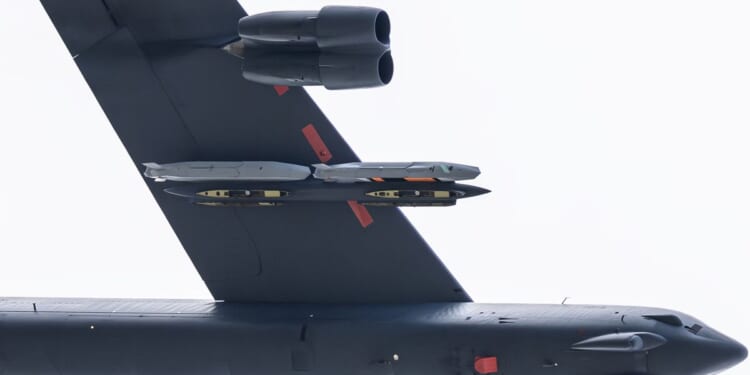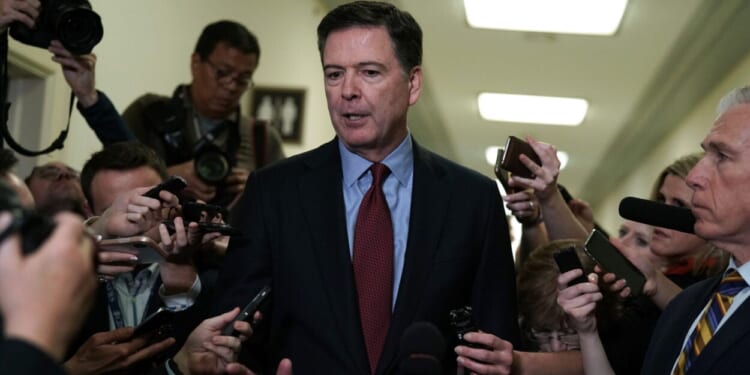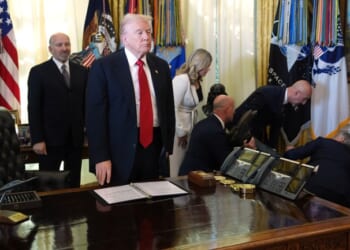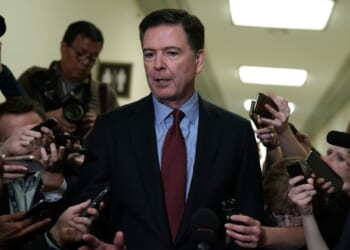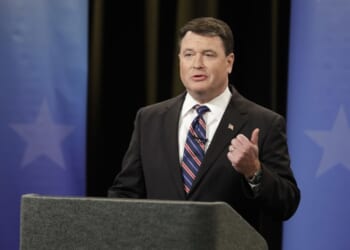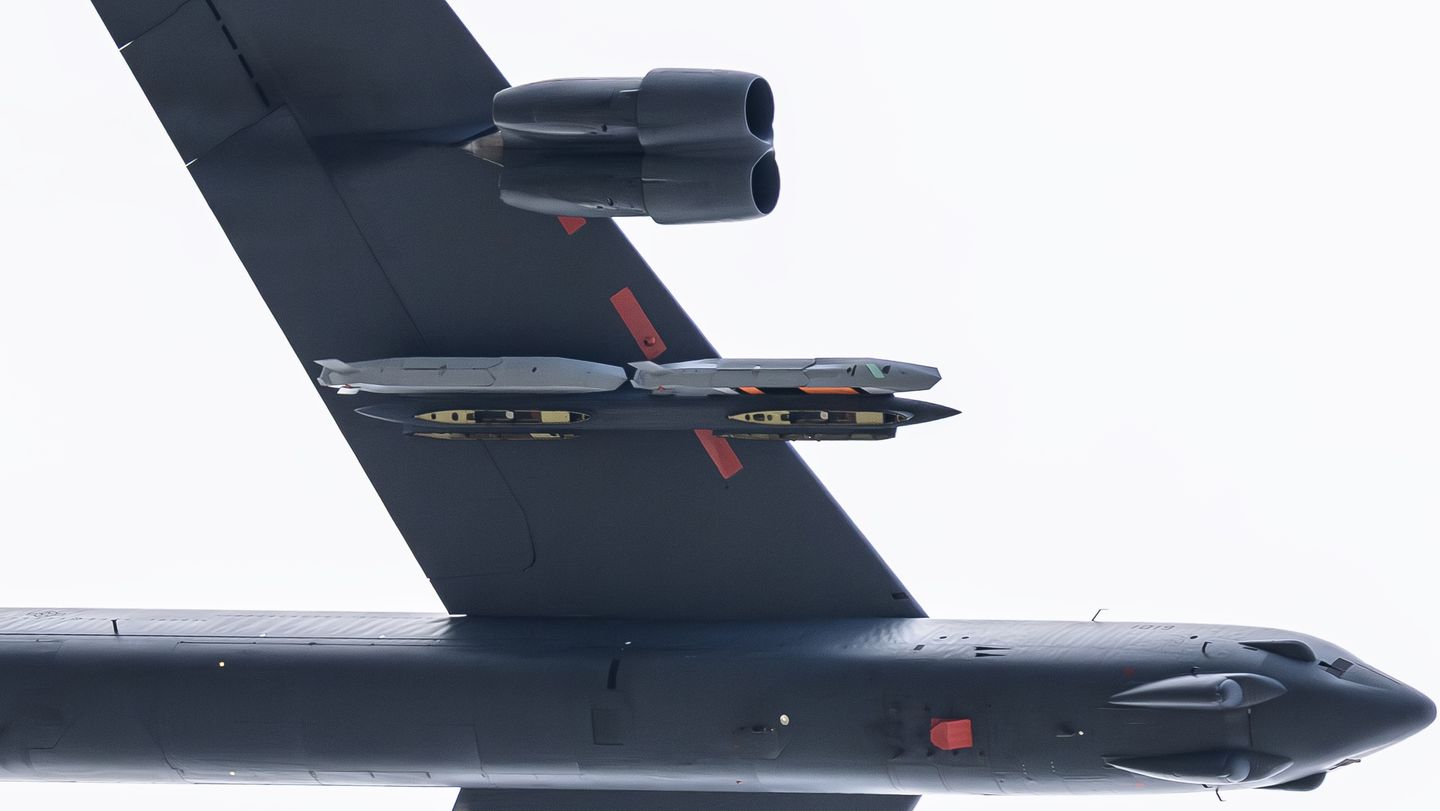
NEWS AND ANALYSIS:
The admiral slated to be the next commander of U.S. Strategic Command said recently that nuclear threats from China and other adversaries are “unprecedented” and growing.
Vice Adm. Richard A. Correll, currently deputy commander at Stratcom, also warned Congress that China’s rapid nuclear weapons expansion highlights the urgent need to fully modernize all elements of the aging U.S. nuclear arsenal.
“China’s ambitious expansion, modernization, and diversification of its nuclear forces has heightened the need for a fully modernized, flexible, full-spectrum strategic deterrence force,” Adm. Correll said in written answers to questions from the Senate Armed Services Committee.
China’s military remains focused on building advanced nuclear missiles, bombers and submarines that will be used to dissuade, deter, or defeat a U.S. intervention in the Indo-Pacific Region.
“China believes these new capabilities offset existing U.S. and allies’ missile defense systems, which may affect their nuclear strike calculus, especially if state survival is at risk,” he said.
In addition to new weapons, including hypersonic missiles, and air-launched ballistic missiles, China has adopted a new military doctrine and other reforms and has begun testing joint military capabilities in and beyond what the three-star admiral called the first island chain — islands in the western Pacific stretching from Japan through the South China Sea.
Adm. Correll said Strategic Command is revising its plans and operations to include integrating nuclear and non-nuclear capabilities in all warfare domains.
“This will convey to China that the United States will not be deterred from defending our interests or those of our allies and partners, and should deterrence fail, having a combat-ready force to achieve the president’s objectives,” he said.
The U.S. is currently modernizing its aging nuclear forces with Sentinel ground-based missiles, Columbia-class missile submarines and the new B-21 bomber. Nuclear command-and-control systems that were first deployed in the 1960s are also being upgraded.
“Today, the United States faces one of the most unprecedented strategic environments in our nation’s history,” he said.
A credible nuclear force structure must provide central, or homeland, and theater or regional deterrence, he said. Combining kinetic and nonkinetic weapons that can conduct strategic strikes will either deny benefits to enemies or impose costs on them, he said.
“Our force posture should include a diversity of platforms and weapons systems that provide additional range, flexibility, survivability and strategic ambiguity regarding conventional or nuclear capabilities,” Adm. Correll said.
A new nuclear-tipped submarine-launched cruise missile and new hypersonic strike missiles are needed to strengthen deterrence, Adm. Correll said.
“Conventional hypersonic strike weapons would directly address distant, defended, and time-critical threats without escalating to nuclear use,” he said.
“These weapons enhance the deterrent effect of the nuclear triad by providing mission planners with a wider range of conventional options across all phases of conflict.”
In addition to China’s rapid nuclear buildup, Russia and North Korea also are expanding and modernizing nuclear forces by deploying new intercontinental ballistic missiles and developing advanced hypersonic weapons, he said.
“Additionally, Russia and China are developing or have already fielded new [nuclear missile submarines] with [submarine-launched ballistic missiles], strategic bombers, and novel weapons meant to defeat U.S. missile defense systems,” Adm. Correll said.
“The efforts of these nations to modernize, expand, and develop new nuclear capabilities will increase the threat as these advanced weapon systems are fielded.”
China’s novel strike weapons include a space-transiting nuclear missile capable of traveling tens of thousands of miles before striking ground targets.
Russia’s new weapons include a nuclear-powered cruise missile and a high-speed underwater drone with a megaton-class nuclear warhead.
Adm. Correll said the Sentinel, Columbia and B-21 programs will ensure strategic deterrence.
However, nuclear modernization on the current scale has not taken place in nearly 40 years. “Consequently, our supporting infrastructure, production capabilities, and defense industrial base have significantly atrophied,” he said.
All three nuclear programs are facing delays, but Adm. Correll said current forces are sufficient to maintain deterrence of all three nuclear adversaries.
Asked by the committee what adjustments are needed to bolster deterrence against China, Russia and North Korea, Adm. Correll said: “We must remain committed to full-scale nuclear modernization, including NC3, fielding hard and deeply buried target weapons, pursuing hypersonic weapons, integrating conventional and nuclear capabilities, and developing supplemental capabilities to enhance our theater nuclear forces.” NC3 is the acronym for nuclear command, control and communications.
The admiral also warned about the dangers of cyberattacks on nuclear command systems, which he said have been made more secure over the past two years.
Adm. Correll said the Air Force’s new nuclear cruise missile, the Long Range Standoff missile, is one of the key systems for U.S. modernization.
New strategic stealth missile spotted on B-52
An online aviation enthusiast has captured the first unofficial images of the Air Force’s new Long Range Standoff nuclear cruise missile, designated the AGM-181.
Aviation photographer Ryan Watamura spotted the new missile known as the LRSO strapped beneath the wing of a B-52 bomber as it made a low-level pass over California last week.
The Pentagon has described the LRSO as a long-range, survivable standoff cruise missile “capable of delivering lethal nuclear effects on strategic targets.”
The new missile will replace the current Air Launched Cruise Missile and can be delivered by both B-52s and the forthcoming B-21 bomber.
The Air Force plans to buy 1,087 LRSO missiles and includes $1.1 billion for the missile in its fiscal 2026 budget.
The Energy Department’s National Nuclear Security Administration is conducting a life extension program on the W-88 nuclear warhead that will be outfitted on the LRSO.
“The LRSO weapon system will be capable of penetrating and surviving advanced integrated air defense systems from significant standoff ranges to prosecute strategic targets in support of the Air Force’s global attack capability and strategic deterrence core function,” the Pentagon said in a report on the missile.
Until the bomber photograph, the Air Force had only released an artist’s conception of the new missile in June.
Air Force Gen. Kenneth S. Wilsbach, the service’s chief of staff, has said the missile is currently within projected cost, schedule and performance criteria.
Pentagon nominee outlines China war strategy
Austin Dahmer, the nominee for a key Pentagon policy position, recently disclosed to Congress new details of plans to deter and defeat Chinese aggression against Taiwan and other states near China’s coasts, known as the first island chain.
“It will take a variety of types of forces, concepts, and posture to effectively deter and, if necessary, defeat a Chinese assault in the First Island Chain,” Mr. Dahmer said in written answers to questions from the Senate Armed Services Committee.
The Pentagon is adopting what he called a “strategy of denial” that would prevent China from successfully attacking Taiwan or other states in the island chain that includes Japan and the Philippines, two key U.S. allies.
“The U.S. strategy of denial complements Taiwan’s plans for layered defense by providing combat-capable forces on operationally relevant timelines, to provide a strong local defense that is difficult and painful to dislodge while bolstering allied confidence in our resolve,” Mr. Dahmer said.
Taiwan must significantly increase defense spending and rapidly acquire new weapons to deter Chinese aggression.
Mr. Dahmer, a former national security aide for Sen. Josh Hawley, also said the U.S. and Taiwan are not alone in deterring Chinese aggression.
Japan’s new Prime Minister Sanae Takaichi recently signaled clearly that an attempted Chinese takeover of Taiwan posed a major threat to Japan, an acknowledgment left unspoken by past leaders.
Support from regional allies is the most important element of deterring China, Mr. Dahmer said. “If we do this, then Beijing’s attempts to expand its influence and dominate its neighbors can be resisted,” he said.
For U.S. forces, new weapons and forces will be needed to strengthen deterrence, including those in space, he said.
Deterring China will require “further maturation and fielding of undersea forces including manned submarines and unmanned undersea vehicles; mobile, ground-based long-range fires; long-range air forces such as bombers; space forces including space control capabilities; and other enabling capabilities,” Mr. Dahmer said.
Like other Trump administration officials, Mr. Dahmer called China’s rapid military expansion “a source of deep concern.”
Beijing’s growing military power “portends not only a direct challenge in the Western Pacific but, if China is successful in dominating in that region, it has the potential for global power projection to impose Beijing’s will well beyond its own shores,” he said.
Maintaining the U.S. military power needed for a denial defense in the first island chain must remain a top Pentagon priority.
“We cannot have a single-threaded solution to the problem of China’s military challenge,” he stated. “It will take a variety of types of forces, concepts, locations, and posture to effectively deter and, if necessary, give the president credible military options to defeat a Chinese assault in the First Island China.”
Mr. Dahmer, currently a deputy undersecretary for policy, is the nominee for what the committee calls the assistant secretary of defense for strategy, plans and capabilities, and what the Pentagon, under its new name, calls the assistant secretary of war for strategy, plans and forces.
Congress has yet to formally authorize the name change from Defense Department to War Department.
Mr. Dahmer came under fire from committee Republicans and Democrats during his nomination hearing last week for several incidents when the Pentagon failed to notify or consult with Congress.
They include details of military strikes on drug boats in the Caribbean, the change of name for Mr. Dahmer’s position, the forthcoming national defense strategy and a review of nuclear submarine cooperation with Australia.
• Contact Bill Gertz on X @BillGertz.

